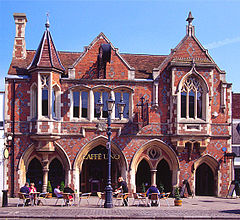Berkhamsted
| Berkhamsted | |
|---|---|
| Town | |
 Berkhamsted Old Town Hall |
|
 Coat of Arms |
|
| Berkhamsted shown within Hertfordshire | |
| Population | 18,100 (2013 est.) |
| OS grid reference | SP993077 |
| District | |
| Shire county | |
| Region | |
| Country | England |
| Sovereign state | United Kingdom |
| Post town | BERKHAMSTED |
| Postcode district | HP4 |
| Dialling code | 01442 |
| Police | Hertfordshire |
| Fire | Hertfordshire |
| Ambulance | East of England |
| EU Parliament | East of England |
| UK Parliament | |
Berkhamsted /ˈbɜːrkəmstɛd/ is a medium-sized historic market town on the western edge of Hertfordshire, England. The affluent commuter town is located in the small Bulbourne valley in the Chiltern Hills, 26 miles (42 km) northwest of London. Berkhamsted is a civil parish, with a town council within the larger borough of Dacorum.
People have been living in the Berkhamsted area for over 5,000 years. There is evidence of flint working in the Neolithic period and metal working in the late Iron Age and Roman periods. The high street is on a pre-Roman route known by its Saxon name Akeman Street. The earliest written reference to Berkhamsted is in 970AD. Berkhamsted was recorded as a 'burbium' (an ancient borough) in the Domesday Book in 1086. The oldest known extant jettied timber-framed building in Great Britain, built 1277 - 1297, survives as a shop on the town's high street. In the 13th and 14th century the town was a wool trading town, with thriving local market.
The most important event in the town's history was in December 1066. After William the Conqueror defeated King Harold's Anglo-Saxon army at the Battle of Hastings, the Anglo-Saxon leadership surrendered to the Norman encampment at Berkhamsted. The event was recorded in the Anglo-Saxon Chronicle. From 1066 to 1495, Berkhamsted Castle was a favoured residence held by many English royals, including Henry II and Edward, the Black Prince; and historical figures such as Thomas Becket and Geoffrey Chaucer. After the castle was abandoned in 1495 the town went into decline, losing its borough status in the second half of the 17th century. Modern Berkhamsted began to expand following the construction of the canal and the railway in the 19th century.
...
Wikipedia

